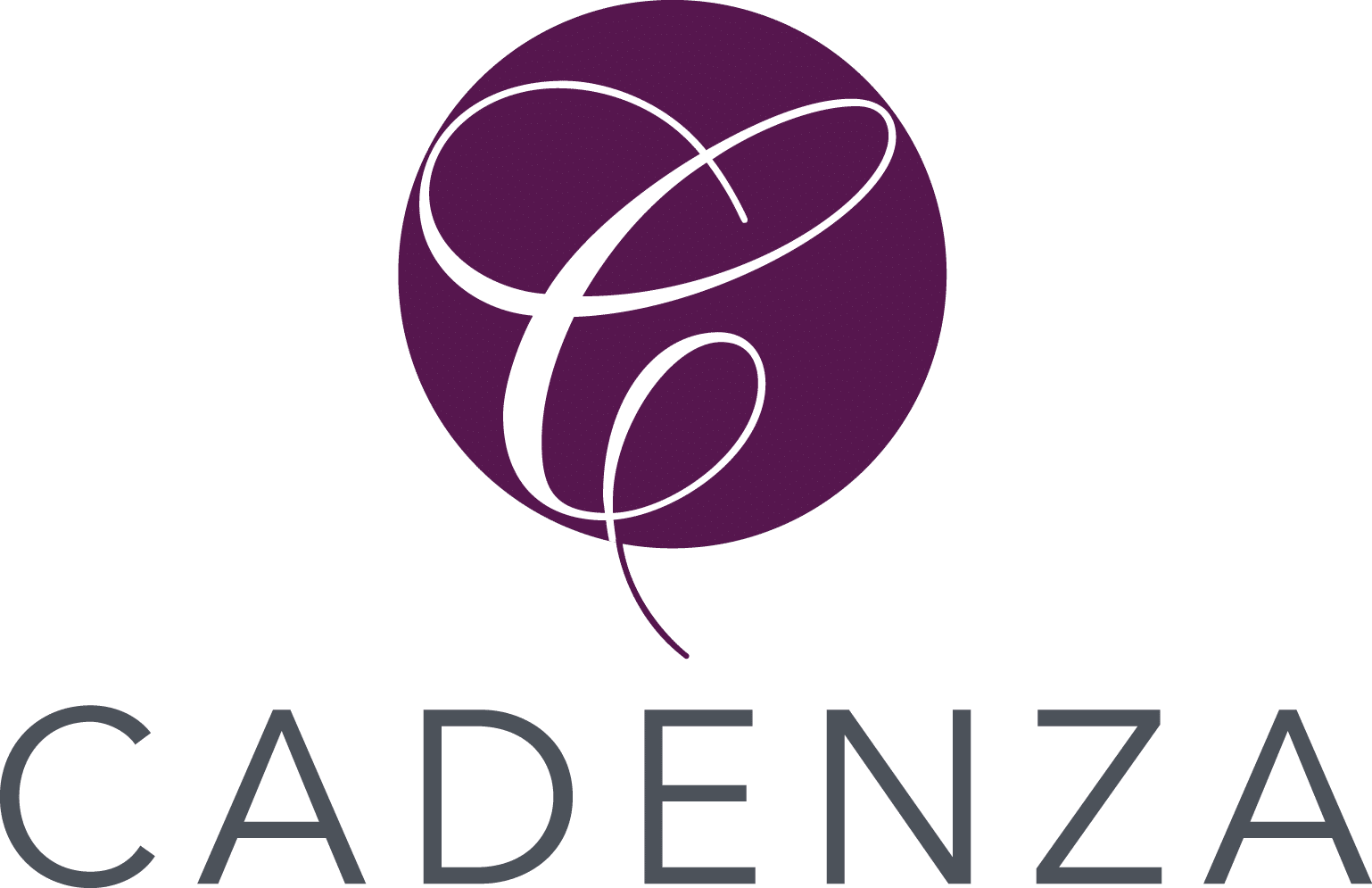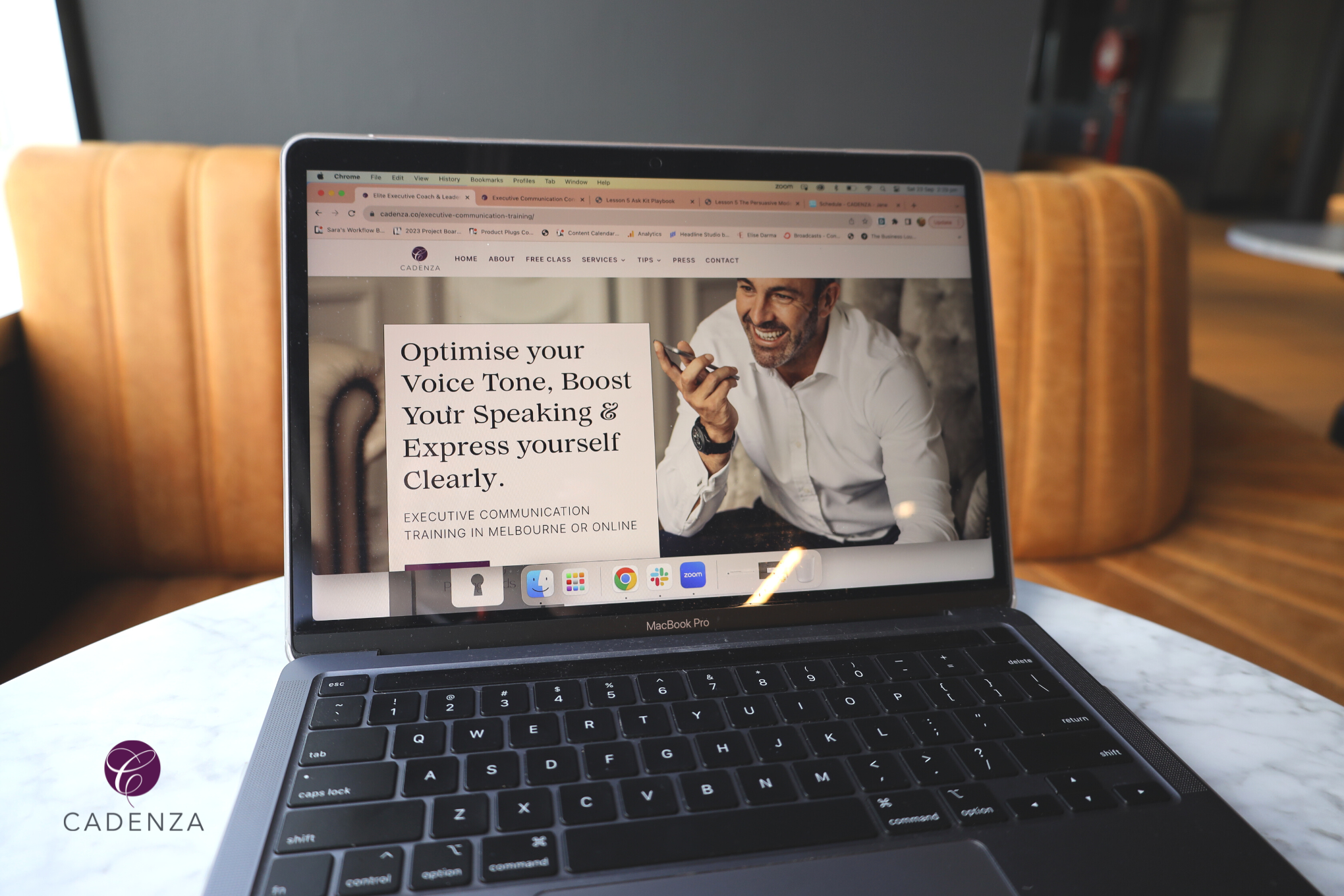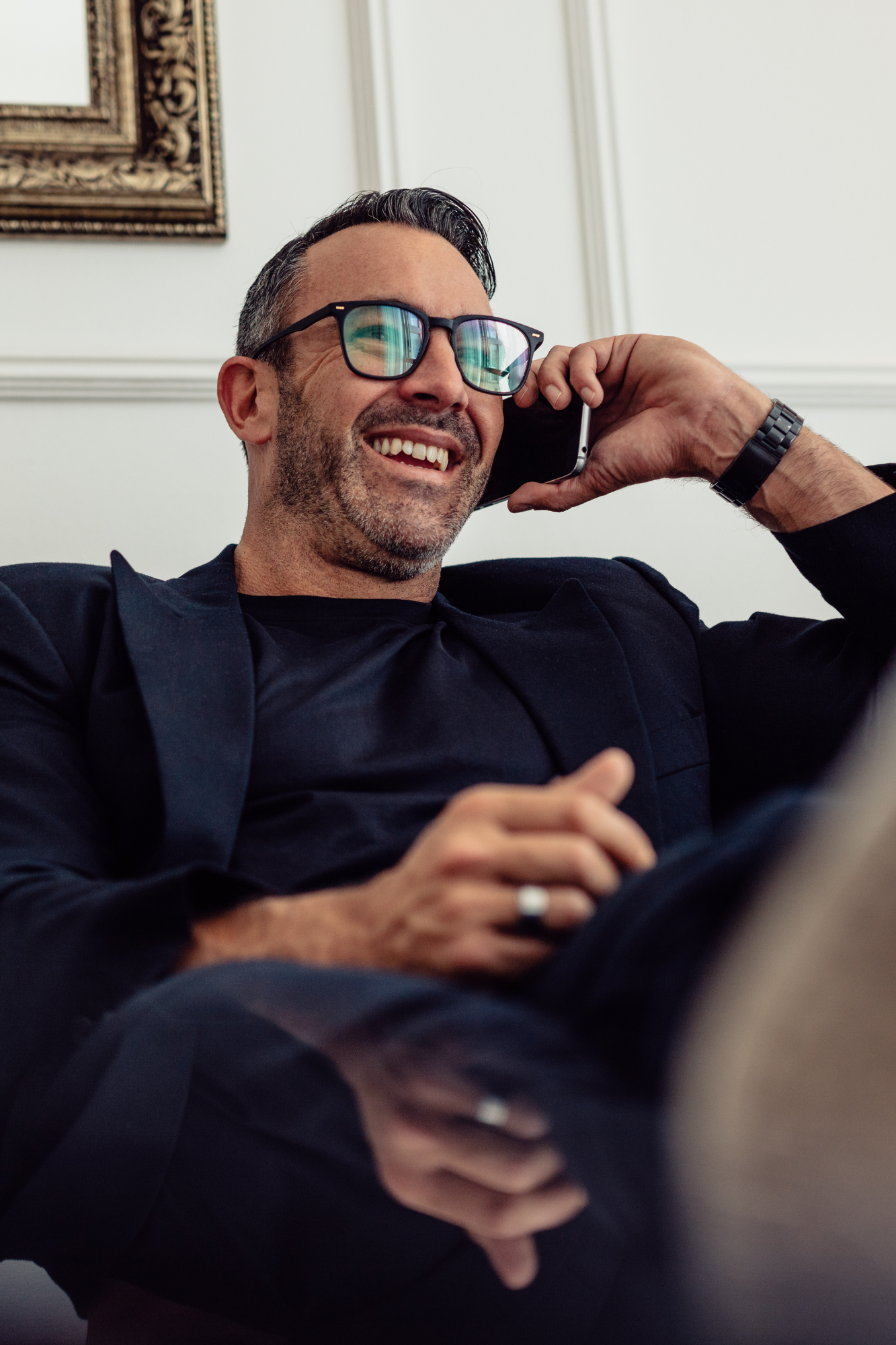Leadership Communication
Media Training Tips: How to Speak Confidently on Camera

There’s nothing like an upcoming media interview to develop the sudden urge to gain compelling communication skills quickly.
Ironically, media appearance opportunities tend to arise when we least expect them, so if you’re looking for some immediate triage to set you up to deliver a persuasive message on the news, in the local media or to a broad audience of listeners, this article will introduce some key considerations and goals to implement.
It’s a skilful art to speak eloquently under pressure with a camera crew and inquisitive journalists on hand. This explains why at Cadenza, CEOs, Founders and Executives who desire to increase their composure and charisma enrol in bespoke media training in Melbourne and abroad with our team.
Keep reading if you’ve not yet worked with Cadenza on media appearance training and are curious about how to look good on the news or in interviews.
Today, we’ll introduce five critical skills you can consider developing that will assist you in improving your speaking so that you can position yourself as an authoritative industry figure before the media and the general public.
While the following recommendations relate directly to speaking on camera, the suggestions are also transferable if you’re about to head into an interview for print, PR or the paper.
This blog post is best digested in 3 parts:
- Check the tips summarised below.
- Watch the vlog for more detailed training.
- Learn more about our elite communication training program for CEOs, Founders and Industry disruptors, which provides detailed strategies on building up elite presenting skills.
Speaking with utmost composure and eloquence on screen is the most viable goal for any media appearance. An eloquent, streamlined, and flowing speaking delivery secures the impression of detailed knowledge of your topic, significantly skewing credibility and trust bias in your favour. Elita media presenters balance composure with their personality, using charisma tactics to keep the viewer listening and engaged. Indeed, fronting a news crew or press room is your ultimate communication agility test. Before you assume that public figures are born with a natural camera presence, think again. Elite communicators are tactically trained in adroit communication because the camera and microphone are unforgiving.
#1 Unshakeable Voice Tone Consistency
When answering difficult questions pitched at you by a journalist, the first tool you need is command of your voice tone under pressure. You should aim for an engaging, credible, assertive tone, especially for the curveball questions. Without the concrete skill of voice tone consistency, your message will come across as erratic and hesitant.
If you don’t know how to regulate your breathing while expressing high-pressure messages, you’ll struggle to retain vocal stamina and clarity from the beginning to the end of statements. In media presence training sessions at Cadenza, we work with CEOs and executives, training vocal reliability. Among other things, you will learn to warm up the voice muscle, which can be a highly effective performance anxiety management tool. Furthermore, warming up the muscle gets it into optimal symmetry so it moves correctly for speaking. This process also trains you to calibrate your breath mechanisms for speaking.
If you’ve noticed that nerves significantly impact your breathing comfort when speaking in high-pressure settings, you’ll need to train your respiratory control in speech pacing.

We don’t recommend signing up for a breathwork class to secure your speaking nerves, as this has no practical application to the set-up needed for an eloquent speaking system. Breathwork might make you feel good, but explicit speaking techniques are the only thing that can make you sound good. At Cadenza, we’ll show you how to integrate verified voice tone tools into your everyday speaking so that you can deliver your message with unshakeable tonality when asked unexpected questions, speaking spontaneously, delivering your elevator pitch or asserting your reasoning.
Charismatic voice tone training ensures you sound confident. It builds your confidence because you will hear vocal boldness as you speak, which reassures you in front of the camera or when someone springs a microphone on you.
There are many individuals offering media appearance training who have some helpful skills, but most programs focus on preparing your message and overlook the sound of your speaking. If you don’t attend to preparing how your message sounds, you’ll sacrifice and sabotage great content with vocal incredulity, hesitation and audible breathing. Voice tone consistency and clarity are the foundation of charismatic media appearances.
#2 Tight and Precise Speaking Content
You only get limited time to answer the big questions when appearing before the media. Journalists are typically busy, fast thinking and speaking professionals, so most people feel like the press room is a den of lions. For this reason, you’ll benefit from the skills to present with a tight and precise structure.
If you’re dealing with someone in public relations, they may give you more time, especially if they’re billing you for their services. But when questioned by the media for a public audience, the person asking the questions will know precisely how to ask the most challenging and ultimately interesting questions.
More often than not, interesting questions are unexpected, unique questions. And this is where most people flounder in a media interview. You’ll see CEOs fumble for words, and politicians hesitate when caught off-guard. You might even notice interviewees give invalid or incorrect responses that conceal the facts, only to be caught out later.
At Cadenza, we assist CEOs, executives, and personalities position themselves as public figures. Media training sessions focus on deploying an integrated, concrete system that allows a rapid response with logical composure.

Logical composure is a non-negotiable skill you must acquire to 10x your presentation skills. It will be indispensable when startled by an unexpected question or topic. If you find yourself getting caught in thought glitches or a black hole while speaking, you’ve identified an opportunity. The opportunity to learn how to communicate with composure spontaneously awaits you. Despite distractions or unexpected conversational coups, you can lift yourself out of a thinking vortex and have something profound to say if you have trained in logical speaking skills.
The worst-case scenario is to script and memorise what you will say. Don’t be tempted to script and memorise your message for the media, as it will impede authentic and personable delivery. Memorised speaking appears unnatural and mechanical and will likely break audience rapport.
Instead of dedicating hours to memorising what to say, focus on training your logical thinking and speaking skills. Tools at Cadenza will help you integrate rapid thinking processes to prepare your words in the heat of the moment. Training in logical speaking strategies will enable you to present valuable contributions to discussions before the media while still sounding personable and authentic.
With precise and well-structured messages, you’ll garner trust and credibility and position yourself as the expert you are.
#3 Reduce Filler Words and Sounds
If you want to position yourself as an influential figurehead, it’s time to consider filler reduction.
Eight filler words and sounds per minute will be problematic for your gravitas and executive presence.
It is simply not ok to say “um” and other such sounds if you want to establish yourself as an expert on your topic. Filler sounds like “um” and “ah”, and filler words like “like” and “the thing is” deplete the integrity of what you’re saying.
Now, we don’t want to sound mechanically composed; the goal is not to sound like Siri; we’ve already mentioned how important it is to sound authentic, but let’s consider how to eradicate fillers successfully.
The solution to filler removal is not telling yourself to cease using them. Instead, the way to halt filler use is to understand the timing of the breath to prepare correct vocal tonality with the voice signal and to understand the timing of the mind to prepare ultimate logical precision. And that is both a mechanical and cognitive process, something that can be incorporated into executive communication consultations at Cadenza.
Filler reduction involves concrete techniques. If you’ve been using “um” your entire life, stopping this without a system that changes the speaking process will be challenging. Targeted speaking content drills will be beneficial for recalibrating and adjusting your speech behaviour.
Optimise your Voice Tone, Boost Your Speaking & Express yourself Clearly.
Presenting anxiety is entirely normal whether in front of an audience, in a pressure-cooker meeting, investor pitch, or behind the camera lens.
Freezing up on stage, moving too much or too little, struggling to project your voice tone or feeling out of sync with your audience are just a few of the challenges we can face when public speaking.
You’re not alone.
If you’ve ever wanted to set the perfect tone for your company with charismatic presentations, media appearances and elegant speaking but have already lost time searching for public speaking courses in Melbourne and feel little inclination to join a generic public speaking class, you should consider my VIP Day for CEOs and Founders. I will train you in the niche tactics you need to become a vocally influential speaker in a way that accelerates your brand and builds your industry visibility.
Because the last thing you want is to be invited to speak for a huge and unexpected opportunity and not be ready.
#4 Elevator Pitch Training
If you become adept with elevator pitches, you’ll feel more ready for media appearances.
Here, you should aim to acquire the skill of succinctly summarising your modus operandi and raison d’etre. If you’re an industry figurehead, there is no doubt you have numerous projects, interests, and values that drive you. As such, your reason for being may vary at multiple moments. Since it’s not ideal to recite the same elevator pitch repeatedly across media appearances, gaining a tool to develop various elevator pitches will be indispensable to your composure on camera. It may appear stagey and mechanical if you rely on the same elevator pitch everywhere. Even though you can’t always say the same thing, you can stand for the same thing. Learning to position an elevator pitch for any moment and conversation will increase your communication agility. You should be able to briefly position a powerful elevator pitch that integrates who you are and why you do what you do in reference to the context of discussion so that your responses before the media showcase a visionary presence and heartfelt passion. This skill will ensure that what you say on camera is relevant to your identity and your audience.
At Cadenza, we train you to concoct an elevator pitch rapidly to suit every discussion. You’ll build speed at concocting plausible and congruent pitches that align with your identity in a matter of seconds so that you can be ready to present logically sound elevator pitches. You can take this skill into the boardroom, to team meetings, and in front of investors or venture capitalists; you won’t save it for media appearances.
#5 Body Proxemics for Camera
Body proxemics relate to how you appear with your body. There’s a critical difference between classic body language principles and looking good on video. For example, you can have impeccable body language for day-to-day conversations but still look awkward, hesitant and fearful on camera.
When it comes to media training, body proxemics relates to considerations of how you stand or sit in reference to the camera lens so that you have the skill and agility to modify your body presence in terms of angles in terms of distance, in terms of the expansiveness or minimisation of movement. Skill in this area pivots around knowing how to build visual gravitas, which is also an essential reinforcer of camera presence to back up the credibility, cohesion and charisma behind your ideas.
Several key manoeuvres will drastically alter how you appear on camera to build rapport and engagement, which we can demonstrate and train you in during executive communication consultations at Cadenza.
Appearing before the media is nothing to be afraid of, especially if you’re talking about something you believe in or enjoy doing. Instead, it’s your chance to show up with credibility, confidence and charisma to present your insights and perspectives. If you want to appear before the media and public without crossing your fingers behind your back in the hope you sound confident, consider concrete media training instead to get you ready. If you aspire to present with unshakeable poise, composure and charisma, consider how integrated verified communication tactics can fast-track elite speaking performance.
Did you enjoy this post? Make sure to subscribe to our YouTube channel to get more content to increase your communication skills!
About the Author
Dr Sarah Lobegeiger de Rodriguez is a Keynote Speaker, Executive Speaking Coach, and Opera Singer who likes to play with words, sounds, and your impact.
Her academic background is in Music Performance, Communication Science and Speech & Language Pathology. She assists executive communication clients all over the world as a communication consultant with strong expertise in CEO, Founder and Entrepreneur communication strategies.
Connect with Sarah on LinkedIn.
© CADENZA
Level 14, 380 St Kilda Road, Melbourne, 3004
Privacy Policy
Terms & Conditions
Position Statement on Racism


